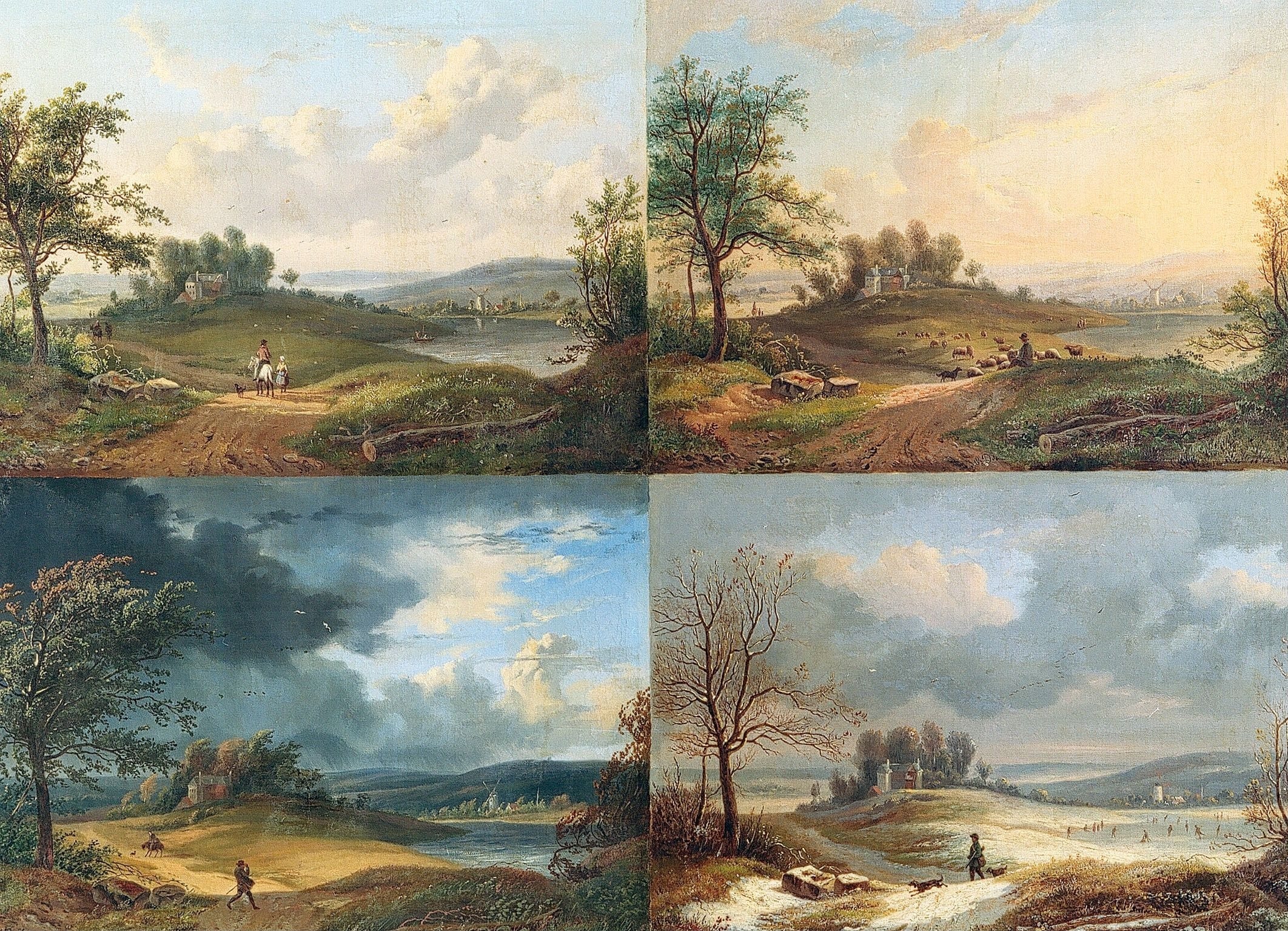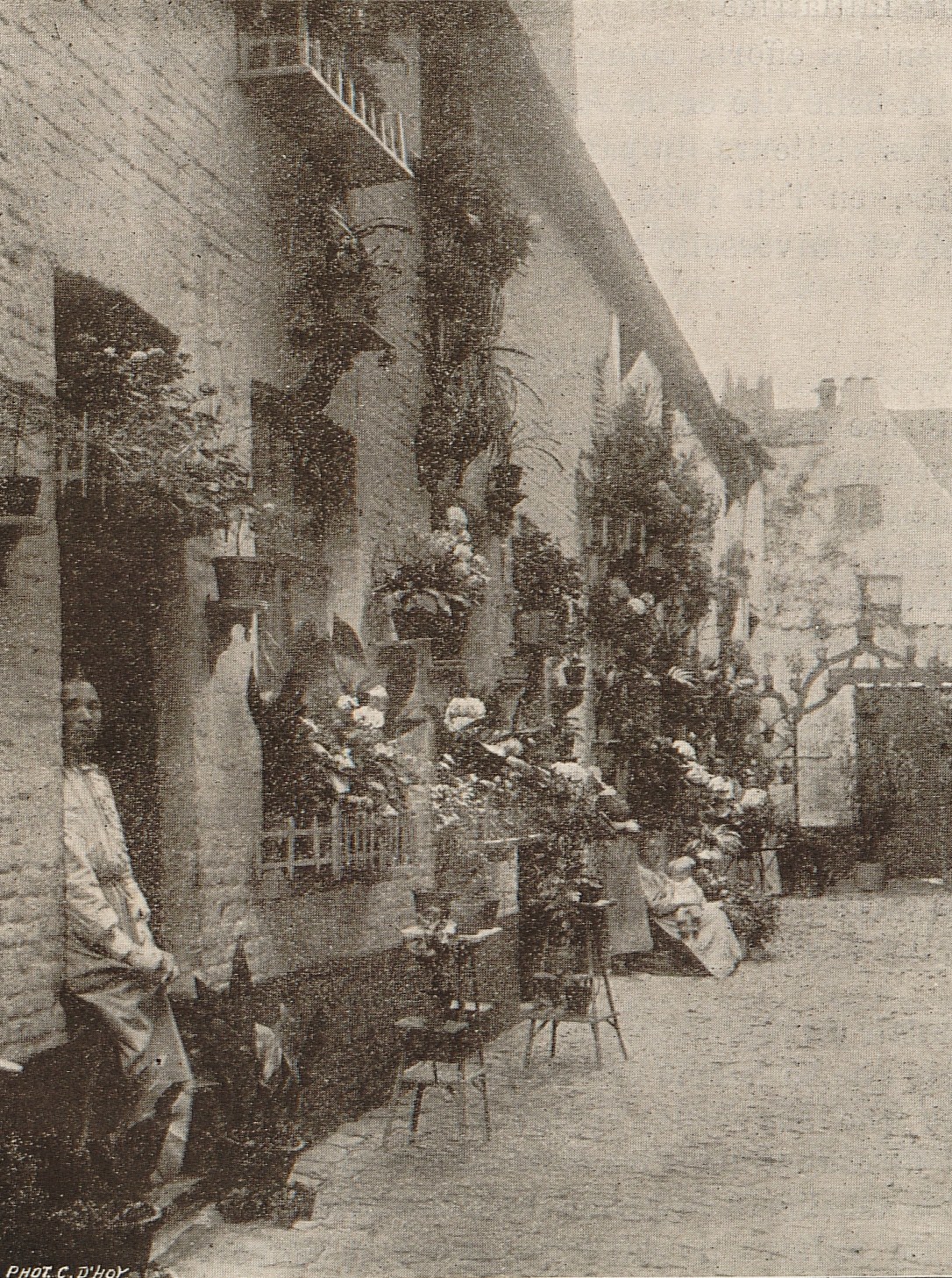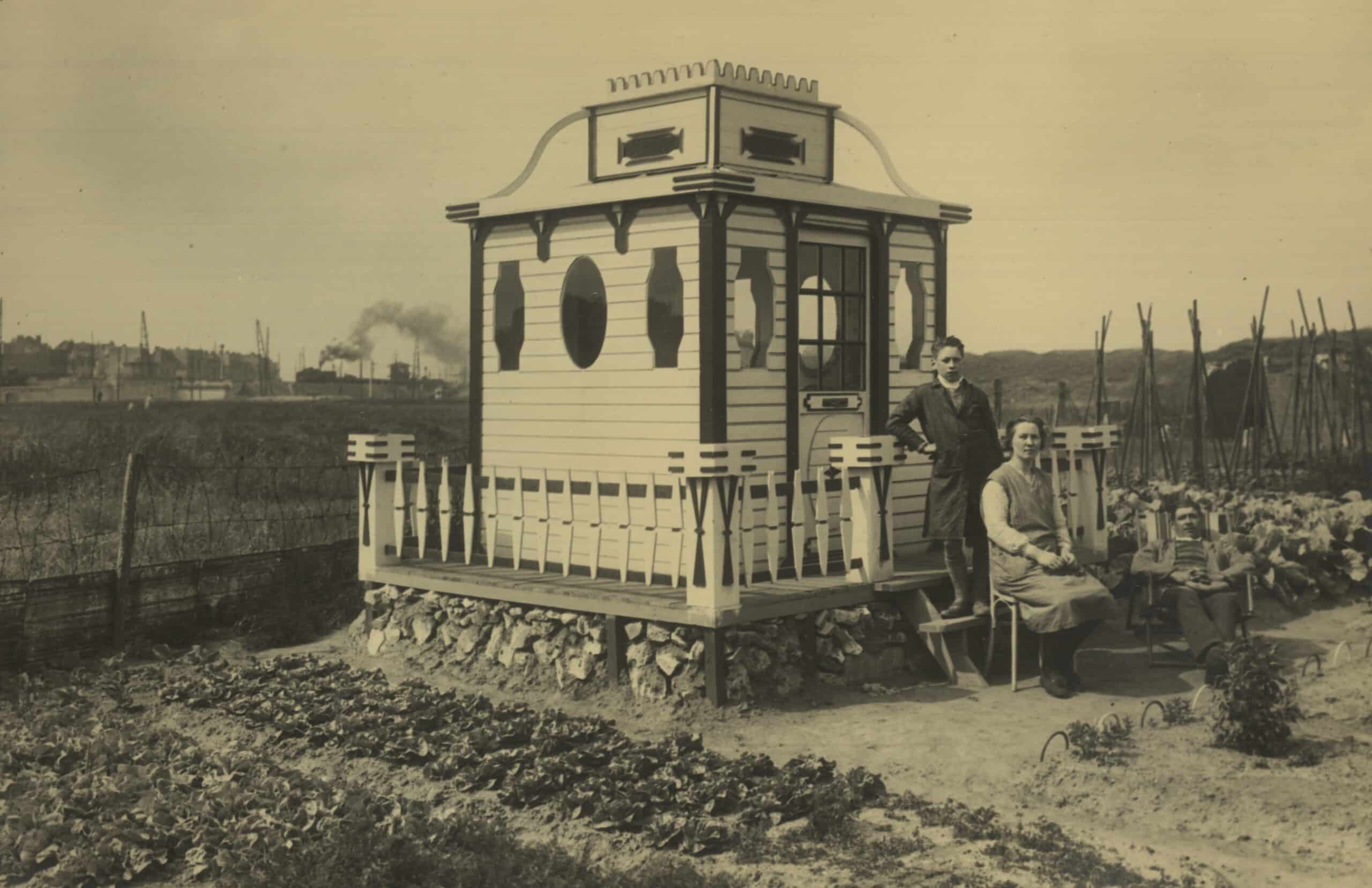Only After 1850 Houseplants Started Creeping Slowly Into Our Bourgeois Houses
Today, it is completely normal to have plants in the house, but it’s not such a long-standing habit as we might think: it was only in the nineteenth century that greenery started creeping into the house. Additionally, this evolution was quite paradoxical: urban against rural, culture against nature, but also public versus private life and even men versus women.
Urban planning reached a high point in the nineteenth century. With a good measure of radicalism and unshakeable belief in their projects, urban planners made short work of sometimes ancient neighbourhoods characterised by a maze of narrow alleys. Often, as a replacement, there arose broad avenues lined with stately gentlemen’s houses and some surprising newcomers: rows of trees. Previously, trees in an urban environment had been viewed in terms of what they yielded – wood – whereas they now acquired a decorative role. So-called squares and certainly city parks signalled an even more ambitious integration: the creation of space for lush nature in the middle of urban sprawl was a hallmark of the nineteenth-century thirst for spectacle.
Ⓒ Revue de l’horticulture belge et étrangère
However enthusiastic the middle classes were about the transformation of public space, the manifestation of this new relationship with greenery did not only occur there. People also began welcoming nature into the more intimate sphere of the home itself, though the incorporation of plants into the home took various forms and was less obvious than we realise today.
Impact of mechanization
The march of nature into the home was intricately linked to the changing relationship between the city and countryside. Around 1800 the landscape of what later became Belgium began to experience the impact of increasing mechanization. Economic transformation brought rapid urbanisation in its wake (particularly in Liege and Antwerp), while factories, railroads and canals relegated the old, agricultural landscape to the past. Or to the artistic imagination: for a long time, until about 1880, landscape painters provided an urban public with reassuring images of an idyllic, harmonious countryside. To this end, they turned to a picturesque visual language, an eighteenth-century aesthetic category.
Artists from the Low Countries, though familiar with the Romantic movement, suffered from a lack of snowy mountain tops, threatening ravines or other sublime views in the landscape of their fatherlands. The picturesque concept, an originally British approach that focused on a degree of roughness, irregularity and especially variety, gave the painter the freedom to combine various elements in one composition and offered a way out. Towards the end of the eighteenth century, this approach changed landscape painting from a rather subordinate into a respected genre, perhaps even more so in the northern Netherlands than in southern regions. The landscape of the Kempen could appear monotonous, as the Antwerp artistic magazine De Vlaemsche School (The Flemish School) argued in 1888, but talented painters were exhorted to extract “lofty emotions” from it, for which “other artists required larger natural scenes.”
 Four seasons by Jan-Baptist Daveloose (1847)
Four seasons by Jan-Baptist Daveloose (1847)Ⓒ Stedelijke musea Kortrijk
The painters themselves determined the shapes their landscapes took on the canvas: they were not bound by harsh reality but, instead, saw it as their mission to elevate that reality. The messages they perceived in nature included neither industrialisation nor urbanisation; the real, visible transformation the traditional landscape was undergoing was left out of the picture in favour of the more reassuring Arcadian harmony and tradition.
The countryside as painters imagined it was not a real place in which to live and work. Instead of being seen as a production zone, it became an object of aesthetic consumption. Moreover, these picturesque conventions were not only limited to the art academies; they captivated an urban audience for many decades – supply and demand are, of course, closely linked in the art world.
Urban art enthusiasts were in the market for decorative works such as portraits, genre pieces and, increasingly, landscapes. The contrast between the urban reality and the idealised countryside became not only more and more pronounced, but undoubtedly contributed to this popularity, which was also stimulated by a wide dissemination of affordable reproductions of paintings and drawings.
landscape scenes underpinned the modern world that they seemed to deny
Stories and poetry on the themes of virtue also brought the contrast of chaos and bustle, simplicity and tranquillity into urban living spaces. It is tempting to see these changes as some form of escapism or even anti-urbanism, but that misses the point. The middle classes that eagerly purchased these clichéd representations of city and nature were precisely those who maintained and developed the new economic reality as entrepreneurs, financiers and consumers. The picturesque scenes provided a recreational and purifying counterweight to urban life: it was specifically because of these shining examples of the constructed countryside that people could find the strength to brave the bustle and continue to function in the city. Immediately, any attempts to counteract the excesses of modern society lost their urgency. In other words: landscape scenes underpinned the modern world that they seemed to deny.
Living nature in middle class intimacy
Paintings inevitably offered only an ephemeral experience of nature. Sunday trips into the countryside deepened that experience but were limited in number and duration. The yearning for a closer relationship with nature in the private sphere brought the physical representations of plants and greenery into the sights of the urban dweller: what if one were to surround oneself with living plants at home and in the garden?
Gardens were the logical place for greenery in the personal living space. Historically, the creation of (ornamental) gardens had been only for noble domains in the countryside; there was little interest in cities for a long time. So long as panoramas and sightlines were the norm in landscaping, the more modest plots of city-dwellers received little interest.
But here, too, the picturesque visual language led to changes. The similarities between painting and gardening became apparent: “Un jardin, à mes yeux, est un fixed tableau” (‘a garden, in my eyes, is a finished canvas’), and were noted in a catalogue published in Brussels from 1829. This publication incorporated separate elements (plants, but also attributes such as benches) which could be used to create a convincing scene. Not only did this act of creation coincide closely with the modus operandi of picturesque painters, it was also an approach perfectly suited to smaller urban land parcels. Gardens became part of the bourgeois lifestyle, their message reflecting that of the paintings on the walls indoors: the value of a pure, harmonious and orderly countryside.
Gardens became part of the bourgeois lifestyle, reflecting the paintings on the walls indoors
Against a background of rapid urbanisation and the related pressure on space, a city garden often seemed difficult to realise in practice. But there was another form of gardening that did offer a way for city dwellers to surround themselves with nature: houseplants could make the bond with nature more intimate than ever before.
The idea of having houseplants was not unknown in the nineteenth century, but it did not become widespread before the 1850s. Until then, the home usually only offered temporary shelter to plants during the cold winter months or on festive occasions. Only later did they become a permanent element of the decor. They crossed the boundaries of the home and penetrated deep into the bastion of bourgeois intimacy, with tables and pots, baskets and vases in every room. For plants the home was, of course, an artificial, poorly adapted environment. But in a society that espoused progress, every obstacle was presented as a challenge and plants were increasingly subjected to human ingenuity.
Ⓒ La Belgique Horticole, 1860
The question of which plants would adorn the pedestal was subject to change. Early on, in the 1820s, the preference leaned towards bulbs such as tulips and hyacinths. A few decades later, blossoms were no longer considered essential, and ferns and palms began to attract attention. Cacti and succulents, with their exotic appearance, fed the picturesque imagination, and better heating and insulation led to the popularity of orchids near the end of the century.
By then, keeping houseplants had matured into a floriculture discipline, with many published guides and regular features in specialised magazines. Those publications reflected some important values of intimate civic life. For example, plants had to be regarded as full members of the family, as the influential Liège ornamental grower Edouard Morren emphasized in 1866: “Les plantes doivent être soignées comme les enfants de la maison.” (‘Plants should be cared for as carefully as the children of the family’). Neatness and order were essential; nonchalance was out of the question.
Houseplants in particular distinguished themselves from other decorative objects because of their need for empathy, love and sensitivity – sentiments regarded as typically feminine. Organised floriculture, with its many meetings and exhibitions, was the business of men as a public activity, but once plants were in the house, they were part of the domain of women. Classic gender roles were thus reinforced: like houseplants, ladies were nowhere more at home than in the home, and both were symbolic of authenticity and naturalness.
Ⓒ Revue de l’horticulture belge et étrangère
In the late nineteenth century the care of houseplants was no longer just about keeping individual plants alive: plentiful advice was given on how to combine varieties of greenery indoors into a coherent, harmonious whole, an activity in which the imagination was not limited because there were so few limits on what occurred in the wild. Lavish and sometimes eccentric scenes with preferably exotic species were a testimony to cleverness.
Paradoxically, plants soon began to lose their naturalness and became more artificial. When the bourgeois lifestyle came under criticism for being artificial in the fin de siècle, that criticism often focused precisely on the decorative role of nature in the home. The title of Maurice Maeterlinck’s symbolist poetry collection Les serres chaudes (The Heated Glasshouses, 1889) is telling: it was a merciless statement about a suffocating society full of unease. Was bourgeois life as deadly to plants as it was to humans?
Social accents
Discontent in the late nineteenth century was widespread. Unlike just a few decades earlier, the transformation of the countryside could no longer be denied and ignored. Many saw the city as an insalubrious, dangerous environment that spurned everything and everyone. The call for change was loud, and the ancient contrast between city and nature was undiminished as a source of inspiration. Renewed energy was devoted to campaigns to protect the countryside from the pernicious influence of the city, supported by the Heimat movement and the earliest nature conservation initiatives.
But the cities were not forgotten. Many attempted to reverse urban decline by making city landscapes more natural. A common strategy was the creation of allotments, a practice that was mainly propagated in Belgium by the Catholic organisation Fruits of the Field and Fireside (1896). The idea was to provide factory workers with a piece of land they could work after their shifts, an exalted alternative to the pub but also a binding agent between agricultural and industrial labour, between tradition and modernity and between nature and the city.
The aim that organisation shared common ground with the gardening associations that flowered in Dutch cities from the 1870s. These groups, staunchly middle class, were designed to teach notions of plant cultivation to the urban working class and, thus, to engage in some “folk improvement”, with annual plant shows and prizes as a stimulus.
Once l'amour des plantes found its way into the working-class mind, any unfolding immorality would be nipped in the bud
In Belgium, this kind of paternalism was perhaps also an important catalyst in changes to the way nature was managed in and around the home circa 1900. Once l’amour des plantes found its way into the working-class mind, any unfolding immorality would be nipped in the bud, or so it was hoped. That is why ornamental growers and authorities set up programmes that included the publication of manuals for the cultivation of house plants in modestly sized homes.
 Winners of a gardening competition in Ghent, 1930.
Winners of a gardening competition in Ghent, 1930.Ⓒ Revue de l’horticulture belge et étrangère
In addition to changes in the target audience, there were other significant shifts: decorative excesses as seen in the rooms of the bourgeoisie were taboo, “la forme la plus naturelle possible” (“the most natural form possible’) became the ideal. But aesthetics was not the ultimate goal. Actively caring for nature was just as important because it was through the maintenance of plants that the proletariat would acquire ideas of tidiness, order and domesticity.
Whether this civilising offensive was highly successful is doubtful. What is certain is that the visibility of plants increased around the turn of the century. Belgian cities were at the centre of the so-called mouvement horticole or horticultural movement. Governments sometimes allocated considerable funds in support of initiatives to clad barracks and train stations – not coincidentally two types of buildings with which large parts of the population came into contact – with flowers and plants. However, the campaign was equally focused on private initiatives. A Brussels competition in 1893 kicked off many awards and provided encouragement for flower-filled balconies and green facades in the capital and elsewhere. It was no exaggeration when commentators wrote that some of the streets were reminiscent of the Hanging Gardens of Babylon.
 A "people's garden" in Borgerhout near Antwerp, around 1930.
A "people's garden" in Borgerhout near Antwerp, around 1930.Ⓒ Archief van het Koninklijk Paleis
The natural decoration of facades was a significant step. Having been welcomed into the home in the mid-1800s, plants now moved one step closer to the public domain and away from the suffocation with which interiors were sometimes associated. And still, flowers and plants remained a source of nature that reduced the distance between city and countryside – and it wasn’t only passive decoration, but also active moralisation, that was the ultimate goal.












